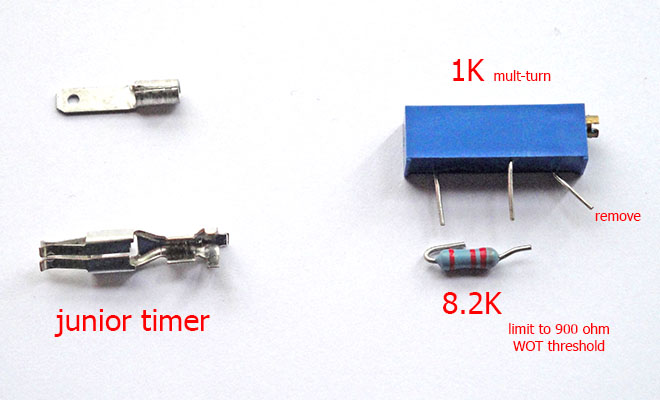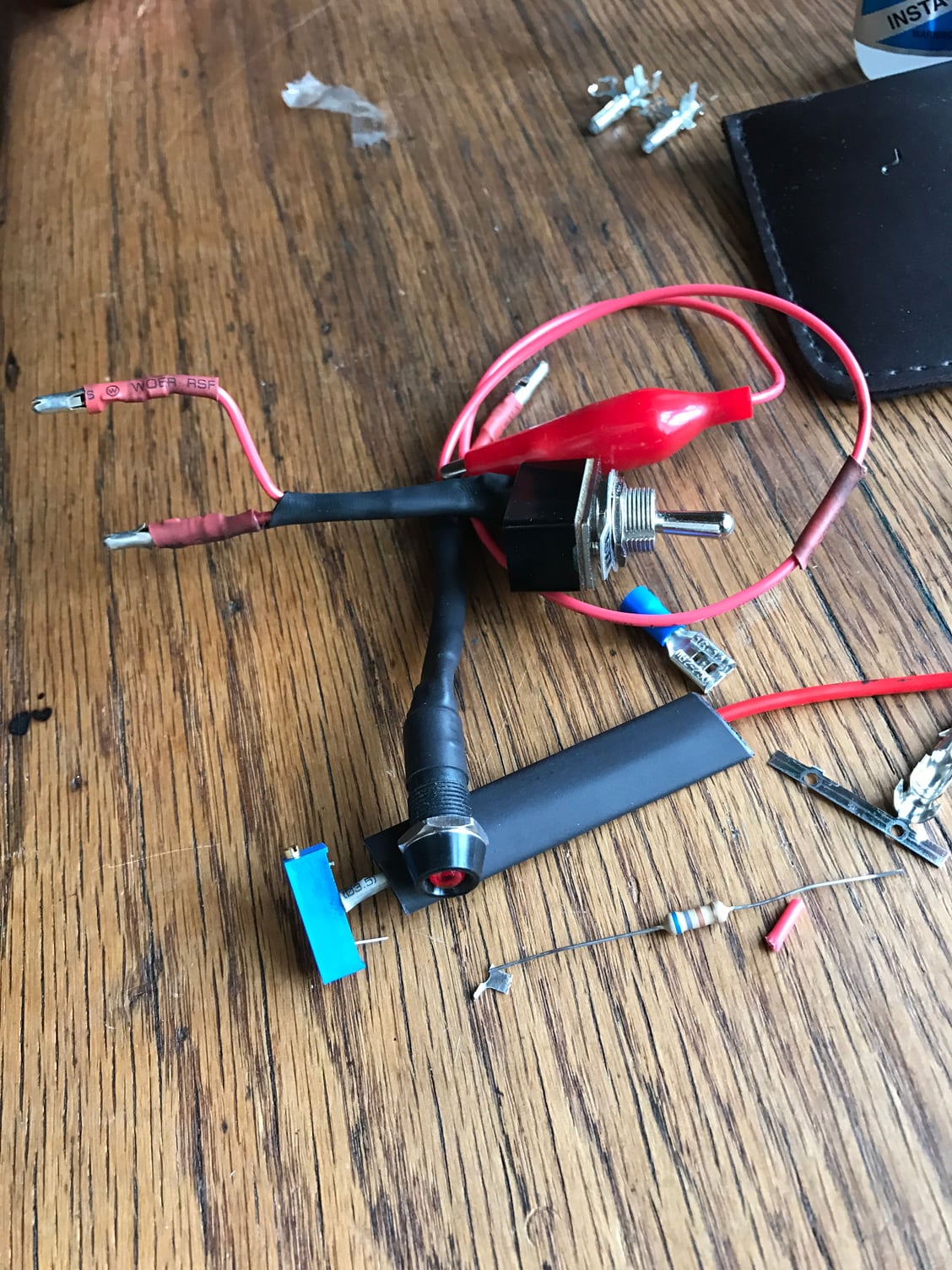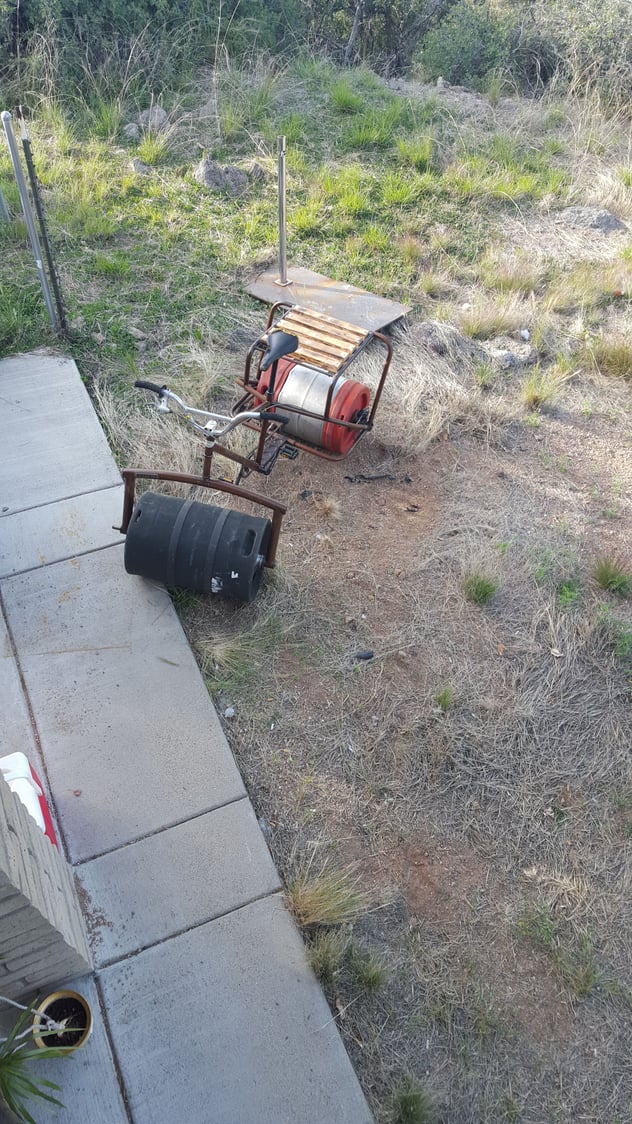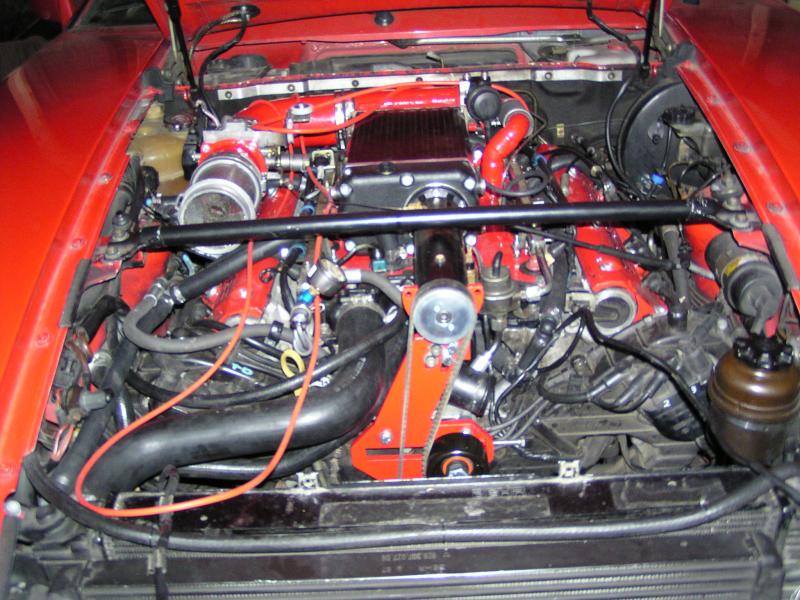Porken that porsche
#31
Nordschleife Master
Moving on to technical topics...
I think that there are three main reasons why the car factories run port injected engines rich under high load:
1) cool the combustion down to avoid knock
2) cool the combustion down even if there's no knock to keep component temperatures down
3) cool the combustion down to reduce nox emissions while accepting somewhat higher unburned hydrocarbon emissions
Anything else?
I think that the first one, avoiding knock, is a valid reason to run rich for a hot-rodded normally aspirated 928.
I think that the second reason is not really valid for a near stock 928. This is because the pistons and valves are so heavy and temperature resistant that you can turbo these engines without any internal changes. These components can take the normally aspirated heat, as long as the engine doesn't knock.
The third reason is either relevant or not relevant depending on the relevance of high load emissions in your specific situation.
In my opinion, steady state (constant rpm) tuning for these near-stock engines therefore comes down to just maximizing the torque at each rpm while avoiding knock. The choices there are ignition timing and AFR. The main unknowns are the variation in fuel octane and the cooling environment.
In terms of evaluating the knock frequencies on the dyno, it of course makes sense to replicate the road conditions as closely as possible.
Also, in terms of knock frequencies, if the engine is tuned close to the edge, then the high-rpm 90-degree and low-rpm 180-degree exhaust blowdown interference is an important issue. Correctly sized long-tube headers can really really help there. The stock exhaust manifold will not evacuate 3, 4, 5, and 7 properly during overlap at low rpms and similarly leave exhaust gas in 1 and 6 at high rpm, causing knock. For S3s that don't have knock sensing, I think headers would make a lot of sense.
My opinion, anyway.
I think that there are three main reasons why the car factories run port injected engines rich under high load:
1) cool the combustion down to avoid knock
2) cool the combustion down even if there's no knock to keep component temperatures down
3) cool the combustion down to reduce nox emissions while accepting somewhat higher unburned hydrocarbon emissions
Anything else?
I think that the first one, avoiding knock, is a valid reason to run rich for a hot-rodded normally aspirated 928.
I think that the second reason is not really valid for a near stock 928. This is because the pistons and valves are so heavy and temperature resistant that you can turbo these engines without any internal changes. These components can take the normally aspirated heat, as long as the engine doesn't knock.
The third reason is either relevant or not relevant depending on the relevance of high load emissions in your specific situation.
In my opinion, steady state (constant rpm) tuning for these near-stock engines therefore comes down to just maximizing the torque at each rpm while avoiding knock. The choices there are ignition timing and AFR. The main unknowns are the variation in fuel octane and the cooling environment.
In terms of evaluating the knock frequencies on the dyno, it of course makes sense to replicate the road conditions as closely as possible.
Also, in terms of knock frequencies, if the engine is tuned close to the edge, then the high-rpm 90-degree and low-rpm 180-degree exhaust blowdown interference is an important issue. Correctly sized long-tube headers can really really help there. The stock exhaust manifold will not evacuate 3, 4, 5, and 7 properly during overlap at low rpms and similarly leave exhaust gas in 1 and 6 at high rpm, causing knock. For S3s that don't have knock sensing, I think headers would make a lot of sense.
My opinion, anyway.
#32
Inventor
Rennlist Member
Rennlist Member
For older computers with few(er) sensors, over-rich fueling off-loop is a band-aid, too.
Weather, MAF age/temperature, altitude, etc. can conspire to make it lean. Generally, winter=lean, summer=rich, low air pressure=rich. At these power levels the mixture doesn't affect the HP output much. (Both S3 and S4 are limited to just over 300 rwhp dynojet by the intake/exhaust.)
In my experience, MAFs, at least the 928 hot-wire type output relative to their internal temperature, making tuning a SOB at times. I programmed some compensation, but I ended up just adding more fuel to be safe, same as the factory.
Note that the stock S4 ignition maps are less aggressive for non-cat cars as the cats create a natural EGR effect, lowering the octane requirement.
Weather, MAF age/temperature, altitude, etc. can conspire to make it lean. Generally, winter=lean, summer=rich, low air pressure=rich. At these power levels the mixture doesn't affect the HP output much. (Both S3 and S4 are limited to just over 300 rwhp dynojet by the intake/exhaust.)
In my experience, MAFs, at least the 928 hot-wire type output relative to their internal temperature, making tuning a SOB at times. I programmed some compensation, but I ended up just adding more fuel to be safe, same as the factory.

Note that the stock S4 ignition maps are less aggressive for non-cat cars as the cats create a natural EGR effect, lowering the octane requirement.
#33
Nordschleife Master
My understanding and limited experience is that the exhaust gas not evacuating from the cylinders during the overlap will make the engine more likely to knock. There's an usually smaller (in my opinion) offsetting effect that the cylinder filling is worse if the exhaust gas is not evacuated. So I'm not a subscriber to that theory, unless if you've actually observed that for S4 taking off the cats will reduce the timing that the engine can take. My personal experience with the turbo car has been the opposite, that is, at high rpms the cats will cause the engine to knock easier and I'll have to back off the boost and timing.
#34
Former Vendor
I just don't understand the argument and the **** slinging, from Ken....but it is his typical response.
His chips are a tuning tool, advertised to increase horsepower. While the horsepower claims are completely invalid, they do make the cars run much better off idle and through the midrange.
Just keep in mind, the only way to increase power output with a set of chips is to increase the timing and decrease the fuel mixture.
Seems like anyone should be smart enough to check their fuel mixture at WOT after doing any tuning and smart enough to suggest that people do this....which is all I'm doing.
His chips are a tuning tool, advertised to increase horsepower. While the horsepower claims are completely invalid, they do make the cars run much better off idle and through the midrange.
Just keep in mind, the only way to increase power output with a set of chips is to increase the timing and decrease the fuel mixture.
Seems like anyone should be smart enough to check their fuel mixture at WOT after doing any tuning and smart enough to suggest that people do this....which is all I'm doing.
#35
Inventor
Rennlist Member
Rennlist Member
Could it be the latent heat with the cat restriction, instead? At least with the turbo.
In my experience, N/A, the spent gases and less charging of fresh air allows/requires higher timing. With an X-pipe, less timing.
Getting (farther) off track, but I spent some snowbound days this winter disassembling the early '87 S4 EZ. It's not Hammer capable (although it has a separate rudimentary serial diagnostic, shared with the later versions, which I assume was only used on the assembly line), fits into <2K bytes of a 4K chip, and doesn't use SRAM at all. This gives a massive 256 bytes of battery-backed 8-bit RAM to play with. I could program a self-tuned 32 cell WOT retard map for each cylinder... it would still only make 305 rwhp, but it would be so cool!
In my experience, N/A, the spent gases and less charging of fresh air allows/requires higher timing. With an X-pipe, less timing.
Getting (farther) off track, but I spent some snowbound days this winter disassembling the early '87 S4 EZ. It's not Hammer capable (although it has a separate rudimentary serial diagnostic, shared with the later versions, which I assume was only used on the assembly line), fits into <2K bytes of a 4K chip, and doesn't use SRAM at all. This gives a massive 256 bytes of battery-backed 8-bit RAM to play with. I could program a self-tuned 32 cell WOT retard map for each cylinder... it would still only make 305 rwhp, but it would be so cool!

#36
Former Vendor
Moving on to technical topics...
I think that there are three main reasons why the car factories run port injected engines rich under high load:
1) cool the combustion down to avoid knock
2) cool the combustion down even if there's no knock to keep component temperatures down
3) cool the combustion down to reduce nox emissions while accepting somewhat higher unburned hydrocarbon emissions
Anything else?
I think that the first one, avoiding knock, is a valid reason to run rich for a hot-rodded normally aspirated 928.
I think that the second reason is not really valid for a near stock 928. This is because the pistons and valves are so heavy and temperature resistant that you can turbo these engines without any internal changes. These components can take the normally aspirated heat, as long as the engine doesn't knock.
The third reason is either relevant or not relevant depending on the relevance of high load emissions in your specific situation.
In my opinion, steady state (constant rpm) tuning for these near-stock engines therefore comes down to just maximizing the torque at each rpm while avoiding knock. The choices there are ignition timing and AFR. The main unknowns are the variation in fuel octane and the cooling environment.
In terms of evaluating the knock frequencies on the dyno, it of course makes sense to replicate the road conditions as closely as possible.
Also, in terms of knock frequencies, if the engine is tuned close to the edge, then the high-rpm 90-degree and low-rpm 180-degree exhaust blowdown interference is an important issue. Correctly sized long-tube headers can really really help there. The stock exhaust manifold will not evacuate 3, 4, 5, and 7 properly during overlap at low rpms and similarly leave exhaust gas in 1 and 6 at high rpm, causing knock. For S3s that don't have knock sensing, I think headers would make a lot of sense.
My opinion, anyway.
I think that there are three main reasons why the car factories run port injected engines rich under high load:
1) cool the combustion down to avoid knock
2) cool the combustion down even if there's no knock to keep component temperatures down
3) cool the combustion down to reduce nox emissions while accepting somewhat higher unburned hydrocarbon emissions
Anything else?
I think that the first one, avoiding knock, is a valid reason to run rich for a hot-rodded normally aspirated 928.
I think that the second reason is not really valid for a near stock 928. This is because the pistons and valves are so heavy and temperature resistant that you can turbo these engines without any internal changes. These components can take the normally aspirated heat, as long as the engine doesn't knock.
The third reason is either relevant or not relevant depending on the relevance of high load emissions in your specific situation.
In my opinion, steady state (constant rpm) tuning for these near-stock engines therefore comes down to just maximizing the torque at each rpm while avoiding knock. The choices there are ignition timing and AFR. The main unknowns are the variation in fuel octane and the cooling environment.
In terms of evaluating the knock frequencies on the dyno, it of course makes sense to replicate the road conditions as closely as possible.
Also, in terms of knock frequencies, if the engine is tuned close to the edge, then the high-rpm 90-degree and low-rpm 180-degree exhaust blowdown interference is an important issue. Correctly sized long-tube headers can really really help there. The stock exhaust manifold will not evacuate 3, 4, 5, and 7 properly during overlap at low rpms and similarly leave exhaust gas in 1 and 6 at high rpm, causing knock. For S3s that don't have knock sensing, I think headers would make a lot of sense.
My opinion, anyway.
Certainly both Bosch and Porsche knew that their MAFs sent a leaner signal as the wire aged. I'm sure they ran their fuel tables slightly rich to compensate for this issue.
It would be sad to "burn an engine down" at 40,000 miles because your MAF was old....
#37
Nordschleife Master
By my guess, the MAF aging is a real issue and led to the so call "adaptation" process in the later LH versions. However, I think that this was mostly a cruise mode instead of WOT mode concern to the factory. Furthermore, I don't think it was a concern about the engine burning down, but concern about emissions test warranty and failing NOx test. I can't read dead people's minds, of course.
Given how massive the pistons are, how thick the ring lands are, and how extremely heat resistant the exhaust valves are, I don't think minor lean conditions and associated heat are a real concern from durability perspective, as long as the engine doesn't knock at high load.
And for knock, I think the ignition timing is the most important determinant. In a stock S3, I think (but don't know) the ignition timing is determined by manifold pressure, not MAF. In a stock S4, I think that the WOT ignition timing is independent of the MAF and just a dumb vector that is activated when the WOT switch is triggered. So MAF aging should not be a significant determinant of high-load knock in either stock S3 or S4.
Given how massive the pistons are, how thick the ring lands are, and how extremely heat resistant the exhaust valves are, I don't think minor lean conditions and associated heat are a real concern from durability perspective, as long as the engine doesn't knock at high load.
And for knock, I think the ignition timing is the most important determinant. In a stock S3, I think (but don't know) the ignition timing is determined by manifold pressure, not MAF. In a stock S4, I think that the WOT ignition timing is independent of the MAF and just a dumb vector that is activated when the WOT switch is triggered. So MAF aging should not be a significant determinant of high-load knock in either stock S3 or S4.
Last edited by ptuomov; 02-13-2017 at 06:43 PM.
#38
Nordschleife Master
In the case of replacing the cats with an x-pipe, it may be the case that x-pipe gives a lower exhaust port pressure at IVO and thereby increases cylinder filling. It may be the case that with either cats or x-pipe the cylinder is well evacuated from the exhaust gasses but the x-pipe gets the intake charge flowing fast earlier and leads to better cylinder filling and thus requires less timing.
In terms of the factory cat vs. non-cat tables, there's always the possibility that the factory wanted the cat and non-cat versions to have similar power and therefore retarded the timing on the non-cat version that would have otherwise made more power. That's of course just pure speculation about the possibility by me, I've got no evidence for that.
#39
Advanced
Thread Starter
Join Date: Jan 2015
Location: Prescott AZ
Posts: 58
Likes: 0
Received 0 Likes
on
0 Posts
Best to take Greg's advice on anything-he-does-not-make with a bag of salt!* 
Do not plug the EZ single plugs (green wires) together! This shorts the air temp sensor and will make the car a dud. My S3 chips were conservatively tuned for 89 octane.
It is good to verify your installation with a wideband O2 if you are going to run at full throttle extensively, but most folks do not. Plugging the LH plugs (brown wires) together will enrich WOT somewhat (S300s chips only). I no longer make the WOTpot, but it is not difficult to put together and install.
(WOTpot installation manual)

* It is difficult to realize unless you have dealt with him for a long time, but besides having a classic narcissist personality - a la the POTUS, he really doesn't know much about things he does not know about. He's quite functional, but when it comes down to it, he will make things up lie, then promptly forget/deny that he did. It has taken years for me to teach him just the basic theory about how the timing belt operates in motion. Among his many sins is running a S3 with obvious fuel delivery problems on the dyno, then blaming my chips, etc, etc.
Among his many sins is running a S3 with obvious fuel delivery problems on the dyno, then blaming my chips, etc, etc.

Do not plug the EZ single plugs (green wires) together! This shorts the air temp sensor and will make the car a dud. My S3 chips were conservatively tuned for 89 octane.
It is good to verify your installation with a wideband O2 if you are going to run at full throttle extensively, but most folks do not. Plugging the LH plugs (brown wires) together will enrich WOT somewhat (S300s chips only). I no longer make the WOTpot, but it is not difficult to put together and install.
(WOTpot installation manual)

* It is difficult to realize unless you have dealt with him for a long time, but besides having a classic narcissist personality - a la the POTUS, he really doesn't know much about things he does not know about. He's quite functional, but when it comes down to it, he will make things up lie, then promptly forget/deny that he did. It has taken years for me to teach him just the basic theory about how the timing belt operates in motion.
 Among his many sins is running a S3 with obvious fuel delivery problems on the dyno, then blaming my chips, etc, etc.
Among his many sins is running a S3 with obvious fuel delivery problems on the dyno, then blaming my chips, etc, etc.I appreciate passion in life, especially in ones work. I have 3 National Champion jerseys for cycling on my wall. All were gifts for a job well done.
I did hook up both wires and boy what a dog. I'm putting it back the way it was but I'm not going to be picking on other Porsches till I get some data back.
Innovative arf on order, now to source the parts Ken listed. Thank you very much for that!
I have faith that these chips do exactly what promised. I have more faith in the wealth of knowledge experience has taught others that I have yet to learn.
I will not WOT until I get more data on my car.
Thank you all for your inputs.
Now to fix the auto non unlatching hatch, the "D" doesn't light up, short in stereo, 1 brake light, intermittent drivers window switch, new hatch light, pod doesn't light up at night, and fuel sender.
#41
Inventor
Rennlist Member
Rennlist Member
It may not be logical (it wasn't to me) but the 8.2K resistor goes to both leads of the (WOT)pot, which is why the resistor's leads are bent around in the parts pic.
It's not totally needed, but the high resistance bridge limits the total output of the 1K pot to 900 ohms. Somewhere above that is where WOT is triggered. (The LH input could accept a 2K variable TPS.) Limiting to 900 ohms stops the WOTpot from a confusing all-time WOT situation.
It's not totally needed, but the high resistance bridge limits the total output of the 1K pot to 900 ohms. Somewhere above that is where WOT is triggered. (The LH input could accept a 2K variable TPS.) Limiting to 900 ohms stops the WOTpot from a confusing all-time WOT situation.
#43
Inventor
Rennlist Member
Rennlist Member
Deep thoughts there Jeremy... I'd counter that everyone is on some sort of spectrum. Some folks aren't aware or haven't learned to manage themselves, yet.

Originally Posted by Glinda
Are you a good witch, or a bad witch?

#45
Addict
Rennlist Member
Rennlist Member
Join Date: Jul 2002
Location: Edmonton, Ab
Posts: 2,286
Likes: 0
Received 0 Likes
on
0 Posts





